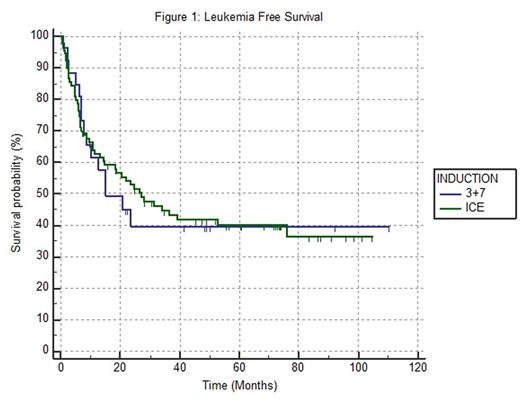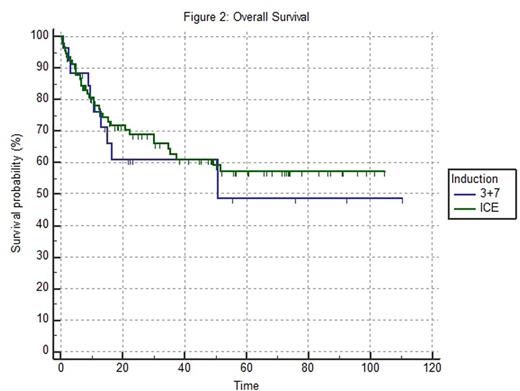Abstract
Introduction: Induction with 3+7 has been standard practice in acute myeloid leukemia (AML) for over 40 years. Addition of a 3rd agent or use of high dose Ara-C has been reported to show better CR rates, but this has not demonstrated a consistent improvement in overall survival. We have consistently used induction with idarubicin, cytarabine 100mg/m2 /day for 7 days and etoposide at 100mg/m2 in young patients, omitting etoposide for suspected secondary AML or AML with myelodysplasia related features, or in those in whom excess toxicity is suspected.
Methods: All patients wholly treated for newly diagnosed AML were identified from the prospective institutional AML database. Patients were treated with either ICE (Idarubicin 12mg/m2 day 1-3, Ara-C 100mg/m2 day 1-7, Etoposide 100mg/m2 d1-3) or the same doses of idarubicin and Ara-C without etoposide (3+7). The latter was given in patients with dysplastic features or secondary AML or where there were concerns of toxicity.
Results:
We Identified 116 patients who received one of the 2 induction regimen between 2005 and 2013. 90 patients received ICE and 26 patients received 3+7. Median ages in the groups were 29y (14-56) and 37y (15-58), respectively.
Cytogenetics by ELN classification were similarly distributed between the ICE and 3+7 groups, with favourable/intermediate/adverse cytogenetics comprising 22%/46%/26% and 23% / 38% / 26%, respectively. 21/90 (23%) in the ICE group had >5% blasts in a day 14 bone marrow vs 7/26 (27%) in the 3+7 cohort. There was no significant difference in the CR/CRi rate between ICE (82%) and 3 + 7 (77%) groups.
The death in aplasia rate was similar at 3.3% and 3.8%, respectively. 65/90 (72%) and 14/26 (54%) of patients received a transplant in CR1 or beyond in the ICE and 3+7 groups, respectively.
Leukemia free survival was 40% (SE 10%) and 40% (SE 5%) in both cohorts (Fig.1). Overall survival at 5 years for ICE and 3+7 were 57% (SE 6%) and 49 % (SE 13%), p=0.69 (Fig.2).
Conclusion:
Our experience in young adults, albeit retrospective, confirms findings of larger studies that demonstrate that addition of etoposide to induction does not appear to improve remission rates significantly or improve survival. In order to improve remission rates in younger adults, FLAG-Ida or other regimens consisting of high dose Ara-C and/or novel agents may provide more tangible improvements in remission rates, although strategies that translate these into better overall survival remain elusive and this should be the target of further prospective trials.
No relevant conflicts of interest to declare.
Author notes
Asterisk with author names denotes non-ASH members.



